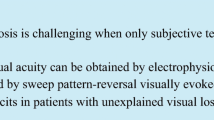Summary
In this study, we aimed to study the pattern visual evoked potentials (P-VEPs) in two eyes with varying visual acuity in one eye and to provide an objective estimation of visual acuity by comparing P-VEPs in one and two eyes. Thirty subjects were chosen, who had one eye with an acuity of 5.0, 4.85, 4.6, 4.0, or scieropia and obstructed vision and the other eye with an acuity of 5.0, respectively. P-VEPs were detected under the large grating stimuli at 3×4 spatial frequency, moderate grating stimuli (12×16 spatial frequency) and small grating stimuli (48×64 spatial frequency). Under large grating stimuli, there was no significant difference in P100 peak latency between the groups, nor was there a significant difference between the amplitude of two eyes and the amplitude of one normal-vision eye. Under moderate and small grating stimuli, there was a significant difference in P100 peak latency between the group with both eyes having an acuity of 5.0 and the group with visual acuity below 4.0 in one eye. There was a significant difference in P100 amplitude between the group with visual acuity of 5.0 in both eyes and the group with one normal-vision eye. There was no significant difference in the amplitude of two eyes and the amplitude of one normal-vision eye between any other two groups. In forensic identification, characteristics and variability of P-VEPs in one and two eyes can be used to identify malingering or decline in visual acuity.
Similar content being viewed by others
References
Katsumi O, Denno S, Arai M, et al. Comparison of preferential looking acuity and pattern reversal visual evoked response acuity in pediatric patients. Graefes Arch Clin Exp Ophthalmol, 1997,235(11):684–690
Norcia AM, Tyler CW. Spatial frequency sweep VEP: visual acuity during the first year of life. Vision Res, 1985,25(10):1399–1408
Ghasia F, Brunstom J, Tychsen L. Visual acuity and visually evoked responses in children with cerebral palsy: Gross Motor Function Classification Scale. Br J Ophthalmol, 2009,93(8):1068–1072
Bach M, Maurer JP, Wolf ME. Visual evoked potential-based acuity assessment in normal vision, artificially degraded vision, and in patients. Br J Ophthalmol, 2008,92(3):396–403
Strasburger H, Remky A, Murray IJ, et al. Objective measurement of contrast sensitivity and visual acuity with the steady-state visual evoked potential. Ger J Ophthalmol, 1996,5(1):42–52
Sun IT, Lee JJ, Huang HM, et al. Pattern visual evoked potentials for identifying malingering. Doc Ophthalmol, 2015,130(3):221–229
Sokol S. Visually evoked potentials: theory, techniques and clinical applications. Surv Ophthalmol, 1976,21(1):18–44
Weinstein GW. Clinical aspects of the visually evoked potential. Ophthalmic Surg, 1978,9(1): 56–65
Howe JW, Mitchell KW, Robson C. Electrophysiological assessment of visual acuity. Trans Ophthalmol Soc U K, 1981,101(1):105–108
Odom JV, Maida TM, Dawson WW, et al. Retinal and cortical pattern responses: a comparison of infants and adults. Am J Optom Physiol Opt, 1983,60(5):369–375
Raniel Y, Pratt H, Neumann E, et al. Miniature fiberoptic pattern-reversal stimulator for determination of the visual evoked potential threshold; comparison with Snellen acuity. Graefes Arch Clin Exp Ophthalmol, 1989,227(3):212–215
Steele M, Seiple WH, Carr RE, et al. The clinical utility of visual-evoked potential acuity testing. Am J Ophthalmol, 1989,108(5):572–577
Emmerson-Hanover R, Shearer DE, Creel DJ, et al. Pattern reversal evoked potentials: gender differences and age-related changes in amplitude and latency. Electroencephalogr Clin Neurophysiol, 1994,92(2):93–101
Jeon J, Oh S, Kyung S. Assessment of visual disability using visual evoked potentials. BMC Ophthalmol, 2012,12:36
di SA, Polo A, Tinazzi M, et al. Binocular interaction in normal vision studied by pattern-reversal visual evoked potential (PR-VEPS). Ital J Neurol Sci, 1997,18(2):81–86
Harter MR, Seiple WH, Salmon L. Binocular summation of visually evoked responses to pattern stimuli in humans. Vision Res, 1973,13(8):1433–1446
White CT, Bonelli L. Binocular summation in the evoked potentials as a function of image quality. Am J Optom Arch Am Acad Optom, 1970,47(4):304–309
Perry NW, Childers DG, McCoy JG. Binocular addition of the visual evoked response at different cortical locations. Vision Res, 1968,8(5):567–573
Amigo G, Fiorentini A, Pirchio M, et al. Binocular vision tested with visual evoked potentials in children and infants. Invest Ophthalmol Vis Sci, 1978,17(9):910–915
Adachi-Usami E, Lehmann D. Monocular and binocular evoked average potential field topography: upper and lower hemiretinal stimuli. Exp Brain Res, 1983,50(2-3):341–346
Shea SL, Aslin RN, McCulloch D. Binocular VEP summation in infants and adults with abnormal binocular histories. Invest Ophthalmol Vis Sci, 1987,28(2):356–365
Leguire LE, Rogers GL, Bremer DL. Visual-evoked response binocular summation in normal and strabismic infants. Defining the critical period. Invest Ophthalmol Vis Sci, 1991,32(1): 126–133
Sloper JJ, Collins AD. Reduction in binocular enhancement of the visual-evoked potential during development accompanies increasing stereoacuity. J Pediatr Ophthalmol Strabismus, 1998,35(3):154–158
Johansson B, Jakobsson P. Fourier analysis of steady-state visual evoked potentials in subjects with normal and defective stereo vision. Doc Ophthalmol, 2000,101(3):233–246
Sloper JJ, Garnham C, Gous P, et al. Reduced binocular beat visual evoked responses and stereoacuity in patients with Duane syndrome. Invest Ophthalmol Vis Sci, 2001,42(12):2826–2830
Mizota A, Hoshino A, Adachi-Usami E, et al. Binocular summation in visual evoked cortical potential in patients who have significantly different P100 peak latencies in their two eyes. Graefes Arch Clin Exp Ophthalmol, 2004,242(9):762–766
Skrandies W. Monocular and binocular neuronal activity in human visual cortex revealed by electrical brain activity mapping. Exp Brain Res, 1993,93(3):516–520
McKerral M, Lachapelle P, Tremblay F, et al. Monocular contribution to the peak time of the binocular pattern visual evoked potential. Doc Ophthalmol, 1995,91(2):181–193
Author information
Authors and Affiliations
Corresponding author
Additional information
This project was supported by the National Key Research and Development Program of China during the Thirteenth Five-Year Plan period (No. 2016YFC0800701-4-2).
Rights and permissions
About this article
Cite this article
Jia, Fq., Liang, Yg., Zhang, Xy. et al. Characteristics of Pattern Visual Evoked Potential in Two Eyes with Varying Visual Acuity in One Eye and Forensic Application. CURR MED SCI 38, 342–348 (2018). https://doi.org/10.1007/s11596-018-1885-2
Received:
Revised:
Published:
Issue Date:
DOI: https://doi.org/10.1007/s11596-018-1885-2




